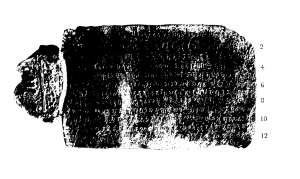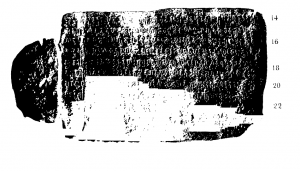

Seal —Of the office of the adhiṣṭhāna (capital) of Koṭivarsha.
On the 5th day of Bhādra in the year 200, 10, 4 (=214), while parama-daivata, paramabhaṭṭāraka, māhārajādhirāja ŚrīBhānu(?)-gupta was the ruler of the earth, and while in the vishaya of Koṭivarsha, prospering under the governmentof the infantry, cavalry and the elephants, (carried on) by Dēvabhaṭṭāraka, the king’s son, . . . . . . . . the uparikamāhārāja of the bhuhti of Puṇḍravardhana, favoured by his imperial Majesty (lit. accepted by the feet of his Majesty), the vishayapatiSvayambhūdēva, appointed to this (post) by him (Dēvabhaṭṭāraka) was administering the affairs of the town (adhiṣṭhāna) in the company of the nagara-śrēshṭhin, Āryya Ribhupala, the merchant Sthāṇudatta, the chief kulika Matidatia, and the chief scribe Skandapāla: whereas application was (thus) made by kulaputraka[1] (the noble man) Amṛitadēva, an inhabitant of Ayodhyā—“In this vishaya (district) prevails the custom of sale of one kulyarāpa of uncultivated khila land which is free from revenue at the rate of three dināras. So it behoves you to make a gift, on accepting from me dināras (as price), of some land by means of a copper-plate grant, according to the custom of apradā[2] (perpetual endowment), for (provision of means of) making repairs[3] of whatever is broken or torn in the shrine of Bhagavān Śvetavarâha-svâmin in the forest here, in order to increase the religions merits of my mother, and for the continuance of bali, charu, satra, the supply of cow’s milk, incense and flowers, and the maintenance of madhuparka, lamp, etc.” It was (then) determined according to the determination of the chief record-keepers, Naranandin, Gōpadatta and Bhaṭanandin, that this application had been properly made in accordance with a spirit of piety . . . . . . a quarrel (?) with the vishayapati. However through his Highness paramabhaṭṭāraka the victory of right is assured. According to this determination, on receiving 15 dinārasfrom this Amṛitadeva, out of consideration for his mother five kulyavdpas of khila land with vāstu were dedicated according to apradā-dharma (the custom of perpetual endowment) to Bhagavān Śvetavarâha-svâmin for use for ever—thus (namely), 2 kulyavdpas with vāstu (habitable land) in both Svachchhandapātaka; . . . . . and Lavaṇgasikā, 1 kulyarāpa with vāstu, in Sāṭuvanāśramska, 1 kulyarāpa with vāstu to the north of Pañchakulyavāpaka[4] and the east of Jambūnadî, and 1 kulyarāpa to the east of the pāṭaka in Pūraṇavṛindikahari.
So in future these (grants) must be preserved (with approval) by the administering agents with due reverence to the gods. There are verses also relating to the grant of land: —
(1) “Whoever confiscates land given by himself or by another becomes a worm in ordure and rats with his forefathers.”
(2) “Land has been given by many kings, such as Sagara and others; the reward (of these grants) belongs to whosoever at any time possesses the earth.”
(3) “The grantor of laud enjoys pleasures in heaven for sixty thousand years; the confiscator and he who approves (of such confiscation) resides even so many years in hell.”
[1] Kulaputraka —a nobly-born youth, a son of a good family. Cf. Mṛchchhakaṭikā kulaputra-mahādrumaḥ, Act IV, V. 10. It seems that the country of Ayōdhyā still formed a part of the dominions ruled over by this Bhānu-gupta (?). Perhaps this Ayōdhyāka Amṛitadēva was a subject of this Gupta ruler: or why should he make such a large gift of land in Puṇḍravardhana (a Gupta territory), so far distant from his own native land?
[2] Apradādharmēṇa tāmrapaṭṭikṛitya, i.e. it must be enjoyed according to this custom of apradā, which seems to refer to the fact that such granted properties could not be transferred, but could only be enjoyed by the grantee perpetually. The corresponding phrase in this connection, as met with in some of the inscriptions of the mahārājas of Uchchakalpa, is ētat puttra-pauttra-prapauttra-tatputirādy-auukkramēṇa tāmra-śāsanēn=ātisṛishṭaḥ (cf. Fleet, C.I.I., Vol. III, No. 28, p. 127).
[3] The word phuṭṭa is a Prakrit form for sphuṭita in Sanskrit. Cf. the same phrasing in II. 15-16 of mahārāja Sarvanātha’s Khoh copper-plate inscription (of the year 193 G.E.). —Fleet, C.I.I., Vol. III, No. 28, p.127.
[4] This word seems to refer to a plot of land having probably for its area five kulyavāpas.